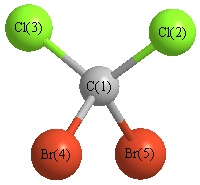All results from a given calculation for CBr2Cl2 (dibromodichloromethane)
using model chemistry: CCSD=FULL/cc-pVTZ
19 10 17 12 22
States and conformations
| State |
Conformation |
minimum conformation |
conformer description |
state description |
| 1 |
1 |
yes |
C2V |
1A1 |
Energy calculated at CCSD=FULL/cc-pVTZ
| | hartrees |
|---|
| Energy at 0K | -6102.994848 |
| Energy at 298.15K | |
| HF Energy | -6101.795962 |
| Nuclear repulsion energy | 852.379880 |
The energy at 298.15K was derived from the energy at 0K
and an integrated heat capacity that used the calculated vibrational frequencies.
Vibrational Frequencies calculated at CCSD=FULL/cc-pVTZ
Geometric Data calculated at CCSD=FULL/cc-pVTZ
Point Group is C2v
Cartesians (Å)
| Atom |
x (Å) |
y (Å) |
z (Å) |
|---|
| C1 |
0.000 |
0.000 |
0.394 |
| Cl2 |
0.000 |
1.441 |
1.413 |
| Cl3 |
0.000 |
-1.441 |
1.413 |
| Br4 |
1.576 |
0.000 |
-0.720 |
| Br5 |
-1.576 |
0.000 |
-0.720 |
Atom - Atom Distances (Å)
| |
C1 |
Cl2 |
Cl3 |
Br4 |
Br5 |
| C1 | | 1.7642 | 1.7642 | 1.9302 | 1.9302 |
Cl2 | 1.7642 | | 2.8811 | 3.0179 | 3.0179 | Cl3 | 1.7642 | 2.8811 | | 3.0179 | 3.0179 | Br4 | 1.9302 | 3.0179 | 3.0179 | | 3.1523 | Br5 | 1.9302 | 3.0179 | 3.0179 | 3.1523 | |
 More geometry information
More geometry information
Calculated Bond Angles
| atom1 |
atom2 |
atom3 |
angle |
|
atom1 |
atom2 |
atom3 |
angle |
| Cl2 |
C1 |
Cl3 |
109.480 |
|
Cl2 |
C1 |
Br4 |
109.466 |
| Cl2 |
C1 |
Br5 |
109.466 |
|
Cl3 |
C1 |
Br4 |
109.466 |
| Cl3 |
C1 |
Br5 |
109.466 |
|
Br4 |
C1 |
Br5 |
109.482 |
Electronic energy levels
Charges, Dipole, Quadrupole and Polarizability
